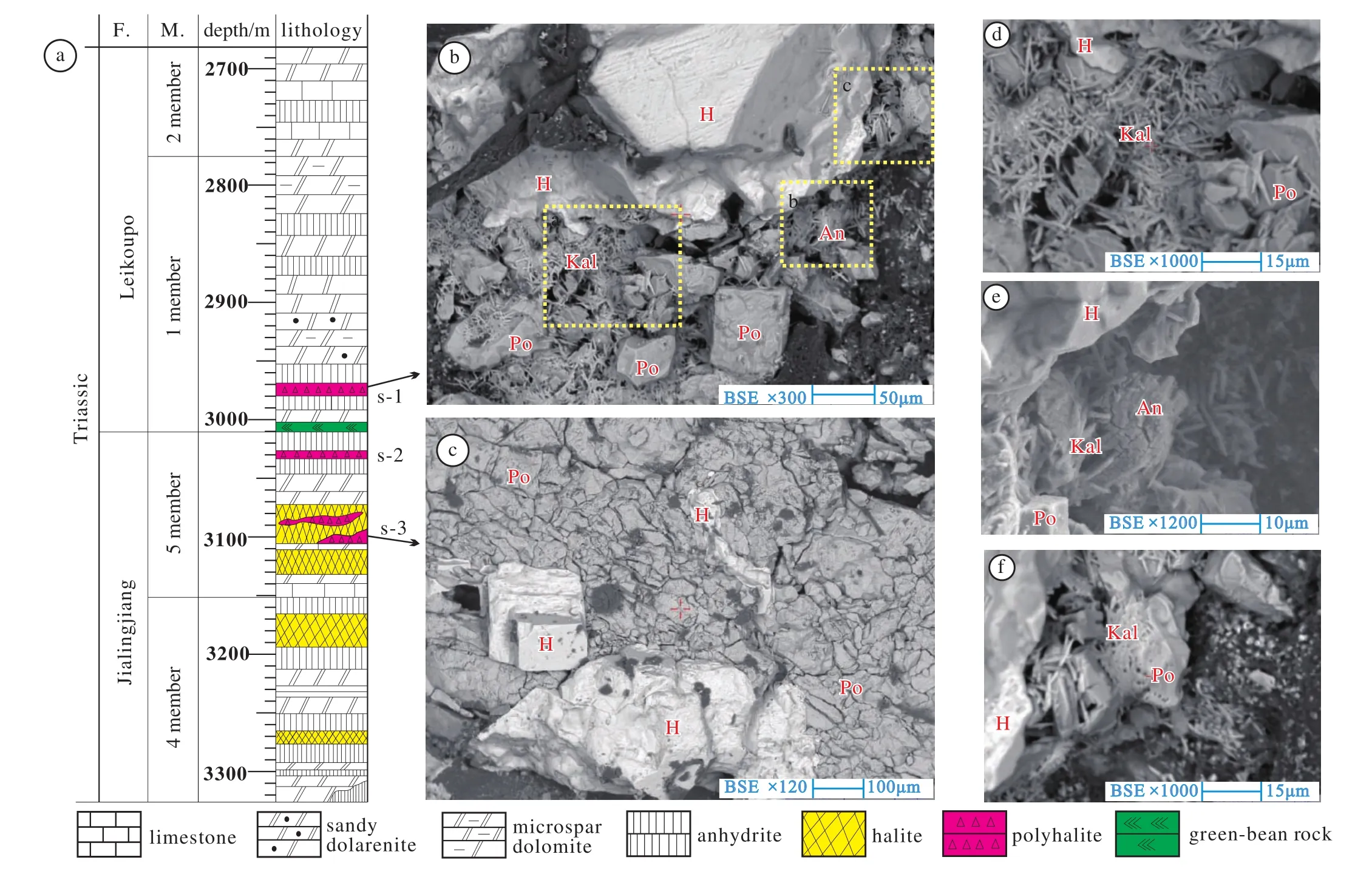Features of micro-fabric and the genetic study of Triassic deep polyhalite in the Guang'an area, central Sichuan Basin
2018-01-13DaxingGongBoHuiJiayunZhou
Da-xing Gong, Bo Hui, Jia-yun Zhou
The Institute of the Multipurpose Utilization of Mineral Resources, Chinese Academy of Geological Sciences, Chengdu 610041, China
1. Objective
It is an accepted fact that the main solid phase support for potassium in the Sichuan Basin is polyhalite[K2MgCa2(SO4)4·2H2O] rather than sylvineis (KCl) (Gong DX et al., 2015).The mineral types, occurrence characteristics and metasomatism of the polyhalite bearing ore-bed were identified and the origin of the polyhalite was discussed.
2. Methods
The polyhalite samples were obtained from the core of Z12, located in Dalong Village, Guang'an City of central Sichuan. The sampling depths were 2974 m (s-1), 3023 m (s-2) and 3106 m (s-3). The microbeam analysis of backscattering images was carried out using a Shimadzu EPMA-1720 Series electron probe micro-analyzer, supplemented by a quantitative spectrum analysis that determined the mineral types.
3. Results
The polyhalite layers occur in the Triassic, from the top of the 5thmember of the Jialingjiang Formation (Fig. 1a) to the bottom of the 1stmember of the Leikoupo Formation.Macroscopically it is off-white to light gray in color, with stratiform-like, lumpy and bedded structures. Two types of polyhalite micro-fabrics can be identified microscopically.
The first type occurs in halite. For example, in S-3, there is a clear boundary between polyhalite and halite (Fig. 1c).Cubic and lumpy halite (60%) with smooth edges and typical stair-step depressions can be observed. A small amount of halite can be seen within intergranular dissolution cavities and fractures. Polyhalite (40%) retains lumpy, plate-like, aggregate and irregular granular structures. Anhydrite and metasomatic phenomena are absent. Chemical analysis reveals that it is rich in K (8.55%), Na (5.22%) and Cl (6.9%),relatively high in Br (275×10-6) and low in Ca (15.21%).
The second type occurs in gypsolyte. The polyhalite coexists with halite, syngenite and anhydrite (s-1, s-2) (Fig.1b). Halite (30%) is a lumpy and irregular particle in shape and has the residue structure of dissolution. Irregular granular polyhalite (40%) shares a clear boundary with halite and anhydrite but does not share a clear boundary with syngenite.They interweave with each other and have a mosaic structure(Fig. 1d). The anhydrite (10%) is irregular granular and fibrous in shape, with a bay-like edge, indicative of the replacement by syngenite (Fig. 1e). Syngenite (20%) displays short prismatic and fibrous structures and has an obvious phenomenon of replacing anhydrite before turning into polyhalite (Fig. 1f). The geochemistry features show high contents of K (8.06%) and Ca (18.15%), and low contents of Na (0.64%), Cl (0.99%) and Br (179.33×10-6). The possible chemical processes are as follows.

Fig. 1.Back-scattering images showing the micro-fabric characteristics of polyhalite from the Guang’an area, Central Sichuan, China.H–halite; Po–polyhalite; Kal–kaluszite; An–anhydrite.

Syngenite + Groundwater rich in Ca and Mg→Polyhalite
4. Conclusions
The two micro-fabrics of polyhalite represent the primary sedimentary and secondary replacement structures,respectively. The first one is formed during the primary sedimentary, or the penecontemporaneous period, when it is separated out from the brine rich in K+, Mg2+, Ca2+and SO42-under the condition of saturation of NaCl. The second type is formed in the backward reaction between the brine rich in K+and Mg2+and the anhydrite formed earlier. Fibrous syngenite is the intermediate state and represents an important transitional stage in the process of anhydrite turning into polyhalite. It is the key mineral indicating the genetic type of polyhalite.
Acknowledgment
This study was supported by the State Key Program of National Natural Science of China (41602120) and the Sichuan Geological Exploration Fund Project (201801). We are very grateful to the Sichuan Best Red Mining Co., Ltd for providing samples.
杂志排行
China Geology的其它文章
- International Union of Geodesy and Geophysics: 27th General Assembly Conference
- Introduction of the Beijing SHRIMP Center (National Science and Technology Infrastructure)
- Land submerged to carbonate platform by conodonts: paleoenvironment reconstruction of the western Gangdese in Tibet during Triassic
- An overview of the resources and environment conditions and major geological problems in the Yangtze River economic zone, China
- Geological characteristics, metallogenic regularities and the exploration of graphite deposits in China
- Exploration and research progress on ion-adsorption type REE deposit in South China
